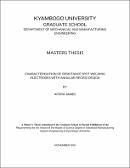| dc.contributor.author | Apora, James | |
| dc.date.accessioned | 2022-03-01T13:08:23Z | |
| dc.date.available | 2022-03-01T13:08:23Z | |
| dc.date.issued | 2018-11 | |
| dc.identifier.citation | Apora, James (2018) Characterisation of resistance spot welding Electrodes with annular recess design | en_US |
| dc.identifier.uri | https://kyuspace.kyu.ac.ug/xmlui/handle/20.500.12504/737 | |
| dc.description | xiii,23 p.: ill (some col) | en_US |
| dc.description.abstract | This study investigated the characteristics of resistance welding electrode with annular
recess design for supplying an electric current to metallic workpieces for welding two
workpieces together. It comprises cylindrical body of an electrically conductive material
(copper) having an annular recess tip for contacting workpiece. The tip is formed with a
recess which gave the tip annular workpiece contacting surface. The recess was filled
with an electrical and heat resistant material containing ceramic cement known as kaolin
mixed with clay. The novel idea of the tool design is to enable formation of molten
material pool which forms weld nuggets with even strength around the joints. The
beginning facts about the recess design tool is that the annular recess minimizes current
and voltage concentration in the middle of the tool tips, thereby; causing molten materials
to flow both to the centre and onto the perimeter of the spot welded joint where the
welding pressure is applied. Studies have shown that conventional spot welding tools
produce joints which are stronger on the edges but weaker in the centre of the nuggets
which presumably experience high voltage concentration. The data collection was done
through RSW welding experiments where welding of sheet metal materials with same
thickness was carried out; alloy steel materials cut from a salvage vehicle were used to
make the sample strips measuring 50mm by 175mm each. The design and manufacture of
annular recess was carried. The welded joints were subjected to different tests to
characterize the weldability and integrity of the welded joints. The tests involved
destructive testing and non-destructive tests of the joints. Magnetic Particle Inspection
(MPI) was used to test the weld joint integrity beside the visual inspection. In this
research study, effect(s) of electrode tip geometry on the tensile-shear strength in
resistance spot welded joints of metal steel sheet (body panel) cut out from an old salvage
vehicle of similar thickness (1mm) was studied. The outcome of this study showed
remarkable improvement on the tensile-shear strength of RSW joint with a nugget
diameter about 8.1mm by approximately 11.4KN using the annular recess electrodes
compared to 5.7KN at nugget diameter of 7.8mm using the conventional electrode. The
annular recess electrode provided an enhanced joint strength by approximately 2 times
than the conventional electrode. Therefore application of this new technique creates a new
tool that can enhance RSW joints strength in metal fabrications and also improvement on
the crash worthiness of the vehicle.
Keywords: Current, Electrode, Nuggets, Resistance, Spot-welding, | en_US |
| dc.language.iso | en | en_US |
| dc.publisher | Kyambogo University (un published work) | en_US |
| dc.subject | Current. | en_US |
| dc.subject | Electrode. | en_US |
| dc.subject | Nuggets. | en_US |
| dc.subject | Resistance. | en_US |
| dc.subject | Spot-welding. | en_US |
| dc.title | Characterisation of resistance spot welding Electrodes with annular recess design | en_US |
| dc.type | Thesis | en_US |

